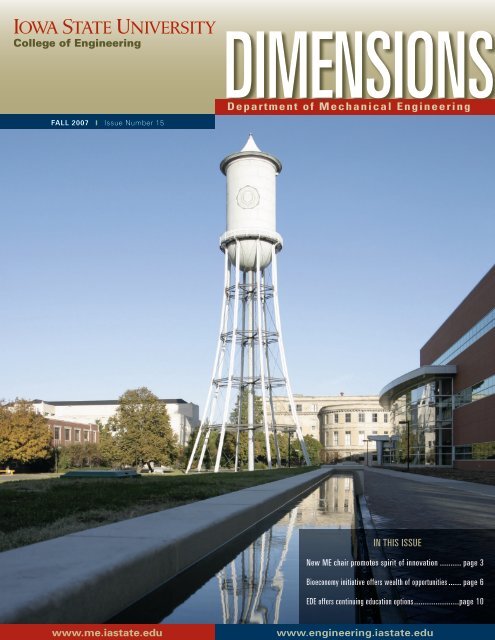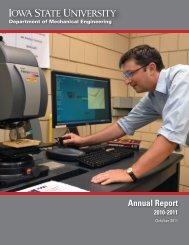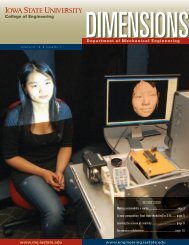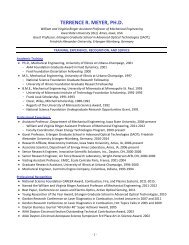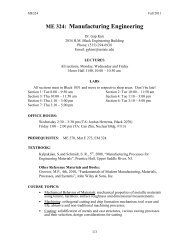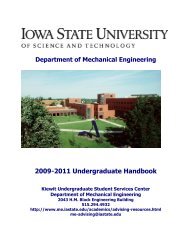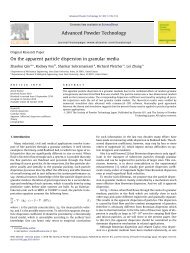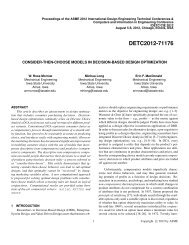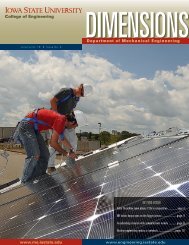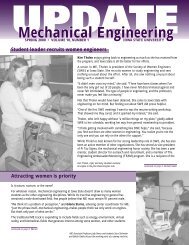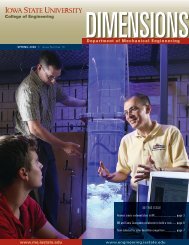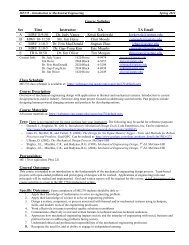Fall 2007 - Mechanical Engineering - Iowa State University
Fall 2007 - Mechanical Engineering - Iowa State University
Fall 2007 - Mechanical Engineering - Iowa State University
- No tags were found...
Create successful ePaper yourself
Turn your PDF publications into a flip-book with our unique Google optimized e-Paper software.
<strong>Fall</strong> <strong>2007</strong> ❙ Issue Number 15DimensionsDepartment of <strong>Mechanical</strong> <strong>Engineering</strong>In this issueNew ME chair promotes spirit of innovation........... page 3Bioeconomy initiative offers wealth of opportunities....... page 6EDE offers continuing education options.....................page 10www.me.iastate.eduwww.engineering.iastate.edu
Message from the ChairThis is an exciting time for mechanical engineering education at <strong>Iowa</strong><strong>State</strong> <strong>University</strong>, and I am truly privileged to serve as the department’snew chair.Through the leadership and stewardship of my immediatepredecessors—previous chair Dr. Judy Vance and interim chair Dr.Mark Bryden—I have inherited a department that by any measure isalready strong in education, research, and professional service.With the combined energy of more than one thousand students andworld-class faculty, we are one of the largest programs in the United<strong>State</strong>s, and our educational heritage is grounded in fundamentalengineering science, laboratory experiences, and design. As our alumnihave moved on to direct major corporations, become entrepreneursin creating their own companies, and lead programs at <strong>Iowa</strong> <strong>State</strong> andother universities, they remain engaged in the department’s life. And thedepartment is nothing without the excellence and initiative of its staffand faculty. I am indeed fortunate to work with such a talented team.We have begun a planning process to envision where we wantthe department to be intellectually positioned in 2025, since that isthe year in which children born today will first enroll as mechanicalengineering freshmen. Why will they have chosen to attend <strong>Iowa</strong><strong>State</strong>? For what educational and research innovations will thedepartment be acclaimed? How will we adapt in the coming decadesto trends in demographics, globalization, the engineering workforce,and technology?By addressing these and other important questions, we will develop astrategy for the department to innovate and lead its profession.Of course, I could go on about the department’s strengths andpotential, but for now let me simply extend my greetings to you andinvite your participation as we plan for the future. Please feel free tocontact me at 515 294-7121 or wickert@iastate.edu.We are poised for an exciting future, and the challenge for the comingyears will be to direct our efforts in ways that will make the greatestcontribution to that future.Jonathan WickertLarry and Pam Pithan Professor of <strong>Mechanical</strong> <strong>Engineering</strong>ME alum Larry Pithan, and his wife, Pam, established the Larry and Pam Pithan Professor of <strong>Mechanical</strong> <strong>Engineering</strong> in June of this year. LarryPithan is senior vice president at KJWW <strong>Engineering</strong> Consultants in Rock Island, Illinois. He earned his BS in mechanical engineering in 1973 andjoined KJWW as a design engineer.“I really appreciate the education I received at <strong>Iowa</strong> <strong>State</strong> and believe it has played a significant part in the success of my career,” Pithan says.The Pithans are long-time contributors to the ME department’s Black-Hilstrom Fund, but decided to make a more significant investment this year.“Pam and I understand the challenges faced by <strong>Iowa</strong> <strong>State</strong> in recruiting and retaining the highest quality faculty and students, and we recognizethe importance of philanthropy in meeting those challenges,” Pithan explains. “We felt this named professorship was a great way to show oursupport for <strong>Iowa</strong> <strong>State</strong>.”continued on page 7ME ‘07 <strong>Fall</strong> Enrollment1,003 undergraduatesLargest department in the College of <strong>Engineering</strong> and at <strong>Iowa</strong> <strong>State</strong>144 graduatesSecond largest graduate program in the College of <strong>Engineering</strong><strong>Fall</strong> <strong>2007</strong> | Issue No. 15Published twice a year by the Department of <strong>Mechanical</strong> <strong>Engineering</strong>,College of <strong>Engineering</strong>, 2025 Black <strong>Engineering</strong>, <strong>Iowa</strong> <strong>State</strong> <strong>University</strong>, Ames, IA50011-2161; www.me.iastate.edu; dmwright@iastate.eduPrepared by <strong>Engineering</strong> Communications and Marketing, College of<strong>Engineering</strong> ECM 08009<strong>Iowa</strong> <strong>State</strong> <strong>University</strong> does not discriminate on the basis of race, color, age,religion, national origin, sexual orientation, gender identity, sex, marital status,disability, or status as a U.S. veteran. Inquiries can be directed to the Directorof Equal Opportunity and Diversity, 3680 Beardshear Hall, 515 294-7612.
New ME chair promotes spirit of innovationJonathan Wickert admits it—rattles and buzzes drive him crazy.As an engineer and a researcher, mechanical engineering’s new department chair studies mechanicalvibration and applied mechanics. He delves into what causes annoying noises, and he works on solutions.But Wickert is also an educator, eager for students to share the excitement of solving problems ininnovative ways. And he is a leader, envisioning the department positioning itself at the forefront of themechanical engineering field.The son of an electrical engineer, Wickert grew up knowing that he also wanted to be an engineer,someone who had the skills to figure out new ways to solve problems. He chose mechanicalengineering for his major at the <strong>University</strong> of California, Berkeley, because he liked the idea of workingwith cars and motorcycles.Wickert’s research, however, extendsbeyond those early interests. His expertisein the fields of mechanical vibration andapplied mechanics combines physicalmodeling, analytical techniques, andmeasurement. One of the applications forhis research is automotive disk brakes.He is the co-inventor of two patenteddevices designed to reduce brake noise.His research also includes applications suchas hard disk drives and robotic libraries forcomputer data storage.“The amount of data stored in enterprise applications is almost unimaginably large,” Wickert says.“We used to talk about kilobytes and megabytes, and now it is gigabytes and terabytes. Imagineholding an electronic version of the print contents of the Library of Congress in the palm of your hand.Whether it is information on a Palm PDA or data collected from video surveillance, you have to be ableto access it quickly, reliably, and precisely.”Jonathan WickertJonathan Wickert joined the <strong>Iowa</strong><strong>State</strong> faculty as the new chair ofthe Department of <strong>Mechanical</strong><strong>Engineering</strong> and as the Larryand Pam Pithan Professor of<strong>Mechanical</strong> <strong>Engineering</strong> on July23. He came to <strong>Iowa</strong> <strong>State</strong> fromCarnegie Mellon <strong>University</strong>,where he had served on thefaculty since 1990. A fellowof the American Society of<strong>Mechanical</strong> Engineers, Wickertis an accomplished educatorand researcher. He wrote thetextbook An Introduction to<strong>Mechanical</strong> <strong>Engineering</strong>, holdstwo U.S. patents, and is theauthor or co-author of more than120 papers in archival journalsand presented at technicalconferences. His research in thefields of mechanical vibration andnoise control combines analyticaltechniques and measurement.While Wickert’s research has practical applications, his focus is on understanding fundamentalphenomena, including stresses, vibration, and deformation, that affect the ability to quickly locatespecific data. “Basic research—that is our role as educators in a university setting,” he explains. “Wecreate knowledge and disseminate it.”Throughout his 17-year tenure at Carnegie Mellon <strong>University</strong>,Wickert placed strong emphasis on teaching. He wrote a textbook,An Introduction to <strong>Mechanical</strong> <strong>Engineering</strong>, to give students a basicunderstanding of the field and to share with them how problemsolvingskills and design analysis lead to real-world applications. He ispresently working on the third edition of this widely used text.Wickert’s accomplishments at Carnegie Mellon included chairinga strategic planning initiative for a five-year roadmap to improveundergraduate and graduate education, leading the effort to createnew laboratories, and collaborating on the development of Web-basedsoftware tutorials.Wickert says he is excited to be at <strong>Iowa</strong> <strong>State</strong> because the mechanical engineering department alreadyhas such outstanding programs and a reputation as a dynamic community of scholars.“The level of enthusiasm here at ISU is great,” he says. “We have to take this energy and focus it.Much is changing in the world, and the department will need to grow and adapt as well. We haveto be innovative as we plan our educational programs and as we develop the next generation ofmechanical engineers.”He has received awards inrecognition of his teaching andresearch from the AmericanSociety of <strong>Mechanical</strong> Engineers,the American Society ofAutomotive Engineers, theAmerican Society for <strong>Engineering</strong>Education, and the InformationStorage Industry Consortium.Wickert earned his BS, MS,and PhD degrees in mechanicalengineering from the <strong>University</strong>of California, Berkeley. He was anNSF/NATO postdoctoral fellowat the <strong>University</strong> of Cambridge,United Kingdom, prior to joiningthe Carnegie Mellon faculty.
ME welcomes three new faculty membersWhen LeAnn Faidley moved to Ames in August2006 to begin her position as an assistantprofessor, it was a homecoming of sorts.Until age 18, she had lived her entire life inRome, Italy, where her father worked for theU.N. Food and Agricultural Organization.But family ties helped influence Faidley toattend <strong>Iowa</strong> <strong>State</strong> as an undergraduate. Her father, LeVern, grew upon a farm near Colfax and is an <strong>Iowa</strong> <strong>State</strong> alum (BSAgE’67), and hermother, Barbara, is a Michigan native. Faidley, who had fond memoriesof summer vacations on her grandparents’ farm, chose <strong>Iowa</strong> <strong>State</strong>because of the science and engineering programs.Terry Meyer also joined the department asan assistant professor in fall 2006. Previously,Meyer worked at Innovative Scientific Solutions,Inc. (ISSI), an Ohio-based engineering researchand development company. At ISSI, heperformed research in advanced propulsionsystems with the Air Force Research Laboratoryat Wright-Patterson Air Force Base.“My long-term goal had always been to teach and do research ata university,” says Meyer, who earned his PhD at the <strong>University</strong> ofIllinois, Urbana-Champaign, in 2001. “First, though, I wanted to build onmy research skills and develop a niche that I could use to establish andsustain a research program.”She earned BS degrees in physics and engineering science in 1999. Asa participant in the Program for Women in Science and <strong>Engineering</strong>,Faidley was assigned a faculty mentor, Alison Flatau—now anaerospace engineering collaborating professor—and worked in Flatau’slab. She was a research assistant throughout her undergraduatestudies and went on to earn an MS in engineering science in 2001.Faidley also earned MS and PhD degrees in mechanical engineering in2005 and 2006, respectively, at The Ohio <strong>State</strong> <strong>University</strong>.Her research—characterization of smart materials—involves figuringout exactly how a material behaves and how it can be used. At Ohio<strong>State</strong>, Faidley worked with magnetic-based smart materials, whichchange their properties (size, shape, flexibility) as a result of changes inthe magnetic field.“I found in my PhD work that you can change the stiffness of nickelmanganese-galiumalmost 200% by altering the magnetic field,”Faidley explains. “A practical application would be for something likevibration control in equipment. Instead of having to replace a springevery time you change some other part of a machine, you can input adifferent voltage and basically change the spring.”For his PhD research at Illinois, Meyer conducted experimentalresearch in turbulent flows that earned him the American Institute ofAeronautics and Astronautics Graduate Award in Fluid Dynamics.At <strong>Iowa</strong> <strong>State</strong>, Meyer is developing advanced tools and techniques forstudying fluids and combustion in harsh environments from gas-turbineengines to rockets and hypersonic vehicles. “The primary goal in thesepower generation systems is to improve efficiency and reduce toxicpollutants,” Meyer says. “These systems have become much morecomplex and are now being modified for use with alternative fuels.As a result, we need a more thorough understanding of the detailedphysics that affect their performance.”Meyer is working with optical and laser-based tools and techniques togain that understanding. “Optical methods are able to peer into andextract spatio-temporally resolved information from environments suchas the middle of a flame zone,” he explains. “Ultimately, we would liketo be able to use optical sensors for intelligent control and operation ofthese devices.”At <strong>Iowa</strong> <strong>State</strong>, Meyer has begun collaborative work with researchers atthe Ames Laboratory and the Office of Biorenewables Programs.Faidley says her experiences as a student helped draw her backto <strong>Iowa</strong> <strong>State</strong>, but the potential for research collaborations withAmes Laboratory, the Center for Nondestructive Evaluation, and theVirtual Reality Applications Center made coming to Ames a uniqueopportunity. She is director of the Active Materials and IntelligentStructures and Systems Laboratory that she established in Howe Halllast fall.And, of course, Faidley is thrilled to teach at her alma mater. As anMS student, she helped Professor Loren Zachary, now assistantdean, design an engineering mechanics class for elementaryeducation majors.From a teaching standpoint, Meyer is putting into practice things helearned while lecturing at the <strong>University</strong> of Illinois. “It’s a challengeto be a good teacher,” he says, “but when done well, it is veryrewarding.”The department’s newest assistant professoris Gap-Yong Kim. Even before startingundergraduate studies at Yonsei <strong>University</strong> inSeoul, Kim could envision himself working in auniversity environment. “My dad is a universityprofessor teaching mechanical engineering inTaegu, South Korea,” Kim says. “I knew from hisexample that I wanted to be a professor, too.”
Vance serves at the NSFAfter completing his BS at Yonsei <strong>University</strong> in 1997,Kim gained valuable experience designing equipmentfor Samick Precision Industry. The South Koreancompany develops and builds custom machinery tomeet the specialized needs of its clients.Kim began graduate studies at the <strong>University</strong> ofMichigan in 2001. He chose Michigan because ofits strong manufacturing/fabrication program andproximity to the automotive industry. He earned anMS in 2003 and a PhD in 2005 and then spent a yearand a half as a postdoctoral fellow before coming to<strong>Iowa</strong> <strong>State</strong> this past August.While at Michigan, Kim developed researchinterests in microscale fabrication technologies andhydrogen energy.“The current technological trend is to make productssuch as cell phones and computers as compact aspossible and, at the same time, enable them to domore tasks at a cheaper price,” Kim says. “I amtrying to look into various fabrication technologiesto achieve this goal by scaling down conventionalsizedmanufacturing processes into very smallscalefabrication factories and by exploring hybridtechnologies to innovatively solve the currentchallenges. But to do that, we first have tounderstand how materials behave at the microscalelevel and why they behave that way.”In his research at <strong>Iowa</strong> <strong>State</strong>, Kim will developmodels to help answer these questions and inventnew fabrication technologies for miniature parts.His long-term research goal is to participate in thedevelopment of technologies for future energysystems that will help address concerns such aspollution, the high demand for energy, and thedepletion of fossil fuel supplies.In addition to setting up his research program, Kimis teaching ME 324, Manufacturing <strong>Engineering</strong>,this fall.“It is exciting to see students interested in learning,”Kim says. “My goal is to motivate students whilehelping them build a greater knowledge base.” Hewants his students to not only understand theory,but be capable of using that knowledge to solve realworldproblems.In fall 2006, Professor Judy M. Vance, accepted a temporaryassignment as program director for engineering design in theCivil, <strong>Mechanical</strong>, and Manufacturing Innovation Division atthe National Science Foundation (NSF) in Arlington, Virginia.At the NSF, Vance recommends funding for research grantstotaling approximately $6.8 million annually and is responsiblefor peer reviews of research proposals submitted in the areaof engineering design.Vance became the first woman chair of the ME department in 2003, a role sheheld until accepting the NSF position. She began her <strong>Iowa</strong> <strong>State</strong> teaching careerwhile in graduate school and worked her way up through the faculty ranks, withpromotion to full professor in 2004. Her research emphasis is on virtual reality,investigating innovative ways to use this advanced technology to improve productdesign and development. She is also a faculty fellow in the <strong>Iowa</strong> <strong>State</strong> Virtual RealityApplications Center.Ted Okiishi retiresME alum Ted Okiishi, who served as ME department chairfrom 1990 to 1995 and as associate dean of engineering forresearch and outreach since 1995, retired in August.A native of Honolulu, Hawaii, Okiishi came to <strong>Iowa</strong> <strong>State</strong>in 1957 to earn a BS in mechanical engineering. Duringhis senior year, his advisor, George Serovy, suggested heconsider graduate school. “George introduced me to a lot ofthings about the world of academics, and I decided being aprofessor would be a very fulfilling profession,” says Okiishi, who earned his MS in1963 and PhD in 1965.Following a two-year ROTC commitment, Okiishi returned to the ME department in1967 as an assistant professor. He became a full professor in 1977.He developed a comprehensive research program building on the work he haddone at NASA Lewis Research Center. With his students, Okiishi conducted gasturbine engine research under the sponsorship of GE Aircraft Engines, TextronLycoming, NASA, the U.S. Air Force, and the National Science Foundation. He andhis co-authors received the American Society of <strong>Mechanical</strong> Engineers MelvilleMedal for best current paper society-wide in both 1989 and 1998.In his role as associate dean, Okiishi was a mentor to faculty and advocate forthe advancement of engineering research, graduate education, and economicdevelopment activities.As a retiree, Okiishi is continuing his involvement with the American Society for<strong>Engineering</strong> Education and the American Society of <strong>Mechanical</strong> <strong>Engineering</strong>. He andhis wife, Rae, will also be involved with service volunteer work and will spend moretime with their children and grandchildren.
Bioeconomy initiative offers wealth of opportunitiesIn April <strong>2007</strong>, ConocoPhillips announced the establishment of an eightyear,$22.5-million research program at <strong>Iowa</strong> <strong>State</strong> <strong>University</strong> dedicatedto developing technologies that produce biorenewable fuels. The grantis among the largest industry grants specifically targeted for biofuelsresearch at a university.The announcement was the latest in a year of highlights related to theuniversity-wide bioeconomy initiative. In October 2006, a campus-widemeeting alerted faculty to the scope of opportunities in biorenewablesresearch, and in November <strong>Iowa</strong> <strong>State</strong> hosted a “call to action”summit that drew more than 400 participants from government,business, industry, agriculture, and academia to discuss the future ofbiorenewables in <strong>Iowa</strong>. In addition, the state of <strong>Iowa</strong> announced fundingof a biorenewables research laboratory building on campus, and theLegislature passed the <strong>Iowa</strong> Power Fund, aimed at keeping the stateon the cutting edge of the renewable fuels industry with investment inresearch and development.The <strong>Iowa</strong> <strong>State</strong> Bioeconomy Initiative was launched in 2002 to developtechnologies for converting crops and plant materials into chemicals,fuels, fibers, and energy. As the <strong>Iowa</strong> Farm Bureau Director of theBiorenewables Programs at <strong>Iowa</strong> <strong>State</strong>, the director of the BioeconomyInstitute (formerly known as the Office of Biorenewables Programs,or OBP), and as the ME department’s Bergles Professor in ThermalScience, Robert C. Brown coordinates the wide range of programs andactivities connected to the initiative.Currently, 150 <strong>Iowa</strong> <strong>State</strong> faculty members with ties to 18 academicdepartments and 19 research centers and institutes on campus areassociated with the Bioeconomy Institute. The researchers haveattracted more than $43 million in cumulative sponsored researchfunding from industry and federal agencies ranging from the Departmentof Agriculture to the National Science Foundation.While biorenewable fuels receive increasing publicity, Brown emphasizesthat they are actually part of a bigger movement—the bioeconomy—forwhich he lists four goals: improve energy security by reducing reliance onimported petroleum; improve environmental quality by reducing emissionsof greenhouse gases; expand markets for U.S. agricultural products; andprovide economic development opportunities for rural America.Researchers are working on numerous technologies that can transformbiomass into biofuels and biobased products. “We don’t know what thepreferred feedstock, process, or fuel will be,” Brown explains. “The fieldis wide open. With investment in research, however, we can developand evaluate the various options.”While Brown oversees the university’s bioeconomy efforts, hisown research has played an instrumental role in developing andunderstanding thermochemical processes such as gasification andpyrolysis to produce biorenewable fuels. His work has helped providethe foundation for <strong>Iowa</strong> <strong>State</strong>’s bioeconomy initiative and has made <strong>Iowa</strong><strong>State</strong> a leader in the field. The ME department plays a major role in <strong>Iowa</strong><strong>State</strong>’s bioeconomy program.One of Brown’s pursuits involves converting biomass to fuel through fastpyrolysis, which is of particular interest to ConocoPhillips. This process usesheat in the absence of oxygen to decompose biomass such as corn stocks,Robert C. Brown, the <strong>Iowa</strong> Farm Bureau Director of <strong>Iowa</strong> <strong>State</strong>’s Office ofBiorenewables Programs, addresses the crowd at the announcement ofConocoPhillips’ eight-year, $22.5-million grant to establish a research programdedicated to developing technologies that produce biorenewable fuels.wood chips, manure, or other biorenewables, into a bio-oil. “The bio-oil canbe refined to gasoline-like fuels in a manner similar to petroleum refining,”says Brown. “It can be produced at processing facilities and stored untilneeded, which is an advantage compared to gasification.”ConocoPhillips will also sponsor studies of other thermochemicaltechnologies that produce biofuels and fund research on environmentalsustainability and rural economies. Brown estimates the researchprogram will involve 10 faculty members, plus graduate students, inthe first year with additional researchers added in subsequent years.Three projects proposed by ME faculty have been approved: Brownwill evaluate alternative methods for producing bio-oil; Ted Heindel,professor, will validate computational models of fluidized bed reactorsused for fast pyrolysis and gasification; and Terry Meyer, assistantprofessor, will study combustion of bio-oil.Other ME faculty are also involved in several projects associated withthe Bioeconomy Initiative.In a project partially funded by the Grow <strong>Iowa</strong> Values Fund, Brownhas teamed up with Heindel, as well as Frontline BioEnergy, anAmes company that produces biomass gasification systems. Theyare studying and designing a gasifier that would be large enough toproduce energy for an ethanol plant. The goal is to use the gasifier asan alternative to natural gas. Since natural gas is the second largestexpense in ethanol production, this could significantly lower costs.Song-Charng Kong, ME assistant professor, is studying biodieselblends. In the quest to reduce petroleum dependency and decreaseemissions, there is increased interest in using diesel engines forelectricity generation. To make that feasible, however, nitrogen oxideemissions from biodiesel blends must be reduced. Kong is conductinga modeling study to determine how timing changes impact emissions.The <strong>Iowa</strong> Energy Center and <strong>Iowa</strong> Association of Municipal Utilities arefunding the project.To learn more about the work being conducted through the OBP,please visit http://www.biorenew.iastate.edu/.
ME students play key role incollege leadership programThe <strong>Engineering</strong> Leadership Program (ELP), which was established in 2006, is focusedon creating an environment that will help students develop strong leadership skills andencourage their active involvement in communities and organizations beyond the university.Minnesota-based 3M Corporation provided support with an initial gift of $500,000.Pithan Professor continued from page 2ME alum Sarah Walter, who graduated in spring <strong>2007</strong> and is nowan engineer at Rolls-Royce in Indianapolis, served as the first ELPstudent director. Walter and Krishna Siddhanta Athreya, ELPdirector, selected 11 juniors and seniors as the first cohort of 3Mscholars in spring 2006. This group, which included 5 ME students,developed program ideas and activities for the new cohort offreshmen, which started in fall 2006. At full-strength, the four-yearprogram will have 60 scholars with a new cohort added each fall.Greg McGrath, ME senior, assumed the role of student directorin June. Adam Bragg, also an ME senior, is one of two associatedirectors. McGrath reports that ELP is continuing to evolve, buildingon the programming developed during the initial year. Plannedactivities include retreats, leadership seminars, and discussionswith business, academic, and political leaders.A major thrust for ELP involves leadership learning experiences.“We are developing the criteria for a leadership learning projectthat the scholars will begin their second year and continue through their senior year,”McGrath says. “The goal is for them to identify a problem of special interest to them andcome up with a potential solution that they can develop and implement. Peer and facultyreviewers will offer input throughout the project.”To learn more about ELP, visit www.eng.iastate.edu/leadership/.Jonathan Wickert, the new chair of the Department of <strong>Mechanical</strong> <strong>Engineering</strong>, is thefirst recipient of the professorship and was formally recognized as the Larry and PamPithan Professor of <strong>Mechanical</strong> <strong>Engineering</strong> at a medallion ceremony this fall.“Pam and I are extremely pleased and honored to be able to support Jonathan Wickert,”Pithan says. “We had the pleasure of meeting Jon recently, and it is obvious he has greatvision and will be an excellent leader for the department.”The Pithan’s gift was made through the ISU Foundation, a private, non-profit corporationdedicated to securing and managing gifts and grants that benefit <strong>Iowa</strong> <strong>State</strong> <strong>University</strong>.For more information on the many ways you can support the Department of <strong>Mechanical</strong><strong>Engineering</strong>, please contact Mary Bilstad at 515 294-1431 or Hyemi Sevening, directorof development, at 515 294-6055. A contribution form is available on page 11.Faculty honors and awardsME faculty have recently received manycollege and university awards in recognition ofoutstanding performance in teaching, research,and service. Congratulations to these honorees.Douglas Beck, academic advisor, College of<strong>Engineering</strong> Superior Advisor AwardJames Bernard, distinguished professor, Collegeof <strong>Engineering</strong> Faculty Leadership AwardMark Bryden, associate professor, <strong>Iowa</strong> <strong>State</strong><strong>University</strong> Margaret Ellen White Graduate FacultyAwardTheodore Heindel, professor, College of<strong>Engineering</strong> Superior <strong>Engineering</strong> Teacher AwardRon Nelson, professor, College of <strong>Engineering</strong>VEISHEA Faculty Recognition AwardMichael Olsen, associate professor, College of<strong>Engineering</strong> Young <strong>Engineering</strong> Faculty ResearchAwardMichael Pate, professor, <strong>Iowa</strong> <strong>State</strong> <strong>University</strong>Louis Thompson Distinguished UndergraduateTeaching AwardRichard Pletcher, professor, Departmentof Aerospace <strong>Engineering</strong> DistinguishedFaculty Award for Significant Contributions toComputational Fluid DynamicsSriram Sundararajan, assistant professor, <strong>Iowa</strong><strong>State</strong> <strong>University</strong> Award for Early Achievementin Teaching; and College of <strong>Engineering</strong> Young<strong>Engineering</strong> Faculty Research AwardR&D 100 AwardR&D magazine selected TBET, a texture-basedengineering tool developed by Mark Brydenand his research team, as one of the top 100innovations in 2006. TBET is part of a virtualengineering software package called VE-Suite thatBryden began developing in 2003. The researchis supported by nearly $1.3 million from the AmesLaboratory. Bryden’s team includes GerrickBivins, who completed his MS in 2005 and nowmanages a software project in Bryden’s lab, andDoug McCorkle, who earned his MS in 2002 andis working on his PhD.
Deal named All-<strong>University</strong> SeniorME senior Chris Deal is one of five <strong>Iowa</strong> <strong>State</strong> students who received the <strong>2007</strong> WallaceE. Barron All-<strong>University</strong> Senior Award. Presented by the <strong>Iowa</strong> <strong>State</strong> <strong>University</strong> AlumniAssociation, the award recognizes outstanding achievement in academics, leadership, andcommunity service.From the time he arrived on campus in 2003, Deal was determined to get involved in a varietyof activities. One of his first—the <strong>Iowa</strong> <strong>State</strong> Dance Marathon, which raises money for theChildren’s Hospital of <strong>Iowa</strong>—became a passion. The experience of meeting the children whobenefit from the event was so inspirational that he got more involved each year. In what Dealdescribes as his proudest accomplishment at <strong>Iowa</strong> <strong>State</strong>, he was co-director of the <strong>2007</strong>marathon that raised a record-breaking $160,664.Deal, who is from Jefferson, <strong>Iowa</strong>, also applied his leadership skills to the Government of theStudent Body as vice president in 2005–2006. “It was a challenge to stay current on many differentissues,” he says, “but in today’s world, you need this kind of diverse background to succeed.”This past summer, Deal was one of 11 engineering students selected from across the countryto participate in the Washington Internships for Students of <strong>Engineering</strong> (WISE) Program. Thisprogram is aimed at helping students learn how government officials make decisions on complextechnological issues and how engineers can contribute to legislative and regulatory public policydecisions. The American Society of <strong>Mechanical</strong> Engineers sponsored Deal’s participation.As part of the internship, each student writes a policy paper on a topic of personal interest. Deal focused on global climate change policy inhis paper, “Climate Change Technology Transfer: Opportunities in the Developing World.” In addition to his research, Deal drew on personalobservations he gained from participation in a three-week study abroad program in China last May that looked at biorenewables and energy.The interns’ papers are online in the WISE Journal of <strong>Engineering</strong> and Public Policy, www.wise-intern.org/journal/<strong>2007</strong>/index.html.After his graduation next May, Deal plans to begin graduate work in sustainable development. He has been selected to receive a RotaryAmbassadorial Scholarship starting in fall 2008.Students take aim at entrepreneurshipSpring <strong>2007</strong> ME graduate Tyler Rasmussen has begun his professional career as a projectengineer with 3M in St. Paul, Minnesota, but he is also an entrepreneur.Throughout his college years, Rasmussen sought out experiences to develop his entrepreneurialskills. In summer 2005, for example, he participated in the Okoboji Summer EntrepreneurshipInstitute, a week filled with seminars and interactions with entrepreneurs and business leaders.He also worked for the Small Business Development Center at the <strong>Iowa</strong> <strong>State</strong> <strong>University</strong>Research Park.Tyler Rasmussen (right) and David Lantzjoin Cy at the 2006 <strong>Engineering</strong> Career Fair.That preparation paid off. Last January, Rasmussen’s friend David Lantz, an aerospace andmaterials science and engineering major, suggested they invent a shot counter for use with airsoftguns. The guns, which fire plastic BBs, are used in recreational activities such as battle simulations.The two students designed a device and applied for and received a provisional patent. “Now wecan put ‘patent pending’ on our product,” Rasmussen explains. “That means we can talk about itwithout worrying that someone will steal it.”Since then, Rasmussen and Lantz have had plenty of opportunity to talk about their invention. They created a business plan to produce andmarket the shot counter and entered it in the <strong>2007</strong> Pappajohn New Venture Business Plan Competition. As regional finalists, they were among12 teams from across <strong>Iowa</strong> selected for the state contest. Although Rasmussen and Lantz didn’t win the $5,000 state prize, Rasmussenreports the experience was positive, and they are moving forward with plans to manufacture their product.
Formula car biofuel powered<strong>Iowa</strong> <strong>State</strong>’s ethanol-powered formula car raced to an 18th-place finishin the field of 130 student-designed and student-built cars at the <strong>2007</strong>Formula SAE (Society of Automotive Engineers) competition last spring.It is the third year in a row <strong>Iowa</strong> <strong>State</strong> has finished in the top 20.With a best-ever 7th-place finish in 2006, the <strong>2007</strong> team focused ongetting more power from the engine and building a suspension thatwould help the car take corners and grip the track better, according toproject director Tony Sartor, a May graduate in logistics and supply chainmanagement. A team of 18 students designed and built the car.The team earned top-20 finishes in acceleration, autocross (a quick andcurvy half-mile course that can be raced at average speeds of 25 to 30mph), and endurance and fuel economy (a 13.7-mile race that featurestop speeds of 65 mph).While the team had problems with last minute assembly issues and oilleaks in the differential, Sartor was pleased with the final outcome. “Thecompetition is getting so fierce, ” he said after the race. “Every team isgetting a lot better. And a lot fewer teams are failing.”When not in the midst of a competition, SAE team members participatein a variety of outreach activities, sharing what they have learned aboutdesigning and building a racecar. Team members frequently talk to highschool and 4-H students both on and off campus. They also participate incommunity/business events such as this fall’s Renewables on Parade heldin Washington, <strong>Iowa</strong>, and the Renewable Energy Expo in Solon, <strong>Iowa</strong>.Kyle Anderson, a senior in mechanical engineering, is the <strong>Iowa</strong> <strong>State</strong>SAE president this year; Ryan Venema, a junior in pre-business, isproject director; and Adam Witthauer, a graduate student in mechanicalengineering, is technical director. To learn more about the <strong>Iowa</strong> <strong>State</strong>Formula SAE team and to follow the team’s progress, visitwww.sae.stuorg.iastate.edu/formula/.Jeff Bartels (left) and Simon Nielsen compete in the AmericanSociety of <strong>Mechanical</strong> Engineers East Coast Challenge in Orlando,Florida, last spring.HPV team focuses onmuscle powerOne group of enterprising ME students has bypassed enginesand solar cells to figure out how to get the most out of humanmuscle power. The human-powered vehicle (HPV) team designedand built a multi-rider HPV named Cyclocity for competition in theAmerican Society of <strong>Mechanical</strong> Engineers (ASME) East CoastChallenge in Orlando last May.While bicycles are the most familiar type of HPV, entries in thiscompetition are specifically designed to be lightweight andaerodynamic. The teams are judged on originality and soundness,written and oral reports, and sprint and endurance events.In designing and building Cyclocity, the students drew from theirexperiences in the 2006 ASME competition, which was the firsteverentry for an <strong>Iowa</strong> <strong>State</strong> team. One major design changerepositioned the riders so they sat back-to-back rather thanfront-to-back. The new design reduced the frame length by twofeet and made the steering more responsive, according to JeffBartels, ME graduate student and the <strong>2007</strong> team leader.The team had a successful showing in Orlando. Cyclocitycompeted against four single-rider teams in the utility enduranceevent and came in first. In addition, <strong>Iowa</strong> <strong>State</strong> finished fourth inthe overall endurance event with 25 single-rider teams competing.Members of <strong>Iowa</strong> <strong>State</strong> <strong>University</strong>’s Formula SAE Team—left to right,Woody Witherow, Jason Lipes, Adam Witthauer, and Kyle Anderson—prepare the car they designed and built for an annual competition at theFord Motor Company’s Michigan Proving Grounds.In the multi-rider events, however, team members weredisappointed to find out they had no direct competitors. Twoother teams were registered, but neither actually competed.“Few teams want to build multi-rider vehicles, because it isharder to figure out how to make the drive train work,” Bartelsexplains. “We like the challenge; plus, it encourages teamworkand allows more people the opportunity to ride.”Jeff Feuerhelm, a junior in mechanical engineering and the 2008team leader, reports the team has started the concept developmentphase for next spring’s competition. To learn more about the HPVteam, visit www3.me.iastate.edu/asme/HPV/HPV_home.html.
<strong>Engineering</strong> Distance Education offers continuingeducation options<strong>Engineering</strong> Distance Education (EDE) at <strong>Iowa</strong> <strong>State</strong>makes it possible to take a single course or completethe entire 27 credits needed to earn an MS degree inmechanical engineering as an off-campus student.EDE classes are delivered through an online systemcalled WebCT. Students can view most classes whilethey are being taught on campus and use live chat tointeract with the professor; or, they can download andview archived lectures at their convenience.That is how Jim Heise, who is now a lecturer and advisorin the ME department, earned his MS degree. Heise, whograduated with his BS in 1986, began graduate work viaEDE in 1999 while working full time and raising a family.“I didn’t have a lot of time to invest in going to classes oncampus so EDE provided a great alternative,” Heise says.“I chose the download option because my scheduledidn’t always allow for watching the lectures when theywere posted. I often could get two to three lectures onone CD and could watch them at my leisure.”It was also easy for Heise to contact his professorsthrough e-mail or phone calls. “They always made timeto answer my questions,” he says.ME Professor Pal Molian teaches class in the <strong>Engineering</strong> Distance Educationclassroom in Howe Hall.Students can take up to nine credits before applying to graduate school, accordingto Adin Mann, ME associate professor and director of graduate education. “Thisgives students a chance to see if taking a class works with their family and workschedules,” he explains.Having an MS degree made it possible for Heise to beappointed as a lecturer in the ME department in 2006when his employer, Maytag, was sold to Whirlpool.“I began graduate work because I thought it wouldexpand my career options in industry,” Heise says. “ButI also knew I wanted to teach after I retired and wouldneed a master’s degree for that. The opportunity to teachjust happened sooner than I anticipated.”All ME graduate classes and some advancedundergraduate courses are available through EDE, andthe department will expand these offerings even more inthe future. The courses offered each semester vary, buta wide selection is available each term. Registration issimple. Go to the EDE Web site (www.ede.iastate.edu/)to find out what courses are being offered and follow theinstructions. The Web site also explains the mechanicsof taking off-campus courses and gives information abouttechnical support and resources. Registration for springsemester began October 17.Many students decide to earn their MS in mechanical engineering. “We don’thave a required number of ME courses that students must take,” Mann pointsout. “They might take industrial engineering or math or business courses alongwith their ME courses. Our focus is for the students to satisfy their personalcareer goals. It is a matter of the student putting together a three-person facultycommittee and planning out a program of study.”All EDE students pay in-state tuition regardless of their location. Current graduatetuition is $347 per credit hour. In addition, students pay a distance education feeof $180 (streaming media/FTP download) or $250 (CD-ROM) per credit hour and acomputer fee based on the number of credit hours being taken.Many companies support their employees’ graduate work, according to Mann,but policies vary so it is important to check out the requirements. He also notesthat undergraduate student loans can often be deferred while a student is ingraduate school.If you have questions about distance education in mechanical engineering orgraduate school, contact Mann at 515 294-2877 or jamann@iastate.edu or MartiSteelman, graduate secretary, at 515 294-0368 or msteelma@iastate.edu forfurther information.
ME alum shares ups and downs of pro basketballME alum Paul Shirley has never worked as anengineer and likely never will. Nevertheless, hehas brought the sort of attention to engineeringand professional athletics that is not commonto either field with his book, Can I Keep MyJersey?: 11 Teams, 5 Countries, and 4 Years inMy Life as a Basketball Vagabond.Growing up in Kansas, Shirley’s dream was toplay professional basketball. A six-foot ten-inchframe combined with good athletic skills andstubborn determination helped make that goalseem achievable, even for a skinny kid fromthe Midwest.He got the chance to further develop hisbasketball skills at <strong>Iowa</strong> <strong>State</strong> helping theCyclones win consecutive Big 12 conferencetitles in 2000 and 2001. Coach Tim Floyd hadrecruited Shirley to play basketball, but asa National Merit Scholarship finalist, Shirleycame to Ames on an academic scholarship.He chose mechanical engineering as his majorbecause he wanted to challenge himself.“Combining basketball and engineering is not the usual path, but it worked out,”Shirley says. “I have caught some flack for my references to Ames, but for me collegewas like a military camp. I went to class and then basketball practice, came homeand went to bed. It wasn’t a lot of fun, but it served mewell. I have had the chance to pursue my dream, and Ihave good friends all over the world.”While Shirley has had limited playing time in theNBA, he is motivated to keep trying. “You can’t reallysucceed unless there is some disappointment alongthe way,” he says. “Even in my wandering career, thedisappointments make the successes feel a lot better,and they are also good learning experiences.”With the publication of his book last spring, Shirley hasgained notoriety for a humorous insider’s view of what itis like to be on the fringes of the NBA. He tells it like hesees it by pointing out the quirks because, he says, thatis what is entertaining to readers. He has also shownthat engineers and athletes can be versatile.“I think people struggle with the idea that a person canbe good at more than one thing,” Shirley says. SethDavis, from Sports Illustrated, agrees. He wrote in hisAugust 22 column, “Shirley’s writing skills are especiallyimpressive considering he is a 29-year-old jock whomajored in mechanical engineering at <strong>Iowa</strong> <strong>State</strong>.”For now, Shirley will continue to pursue a pro basketballcareer. When that is over, he says he will turn hisattention to writing fiction.In the next issue of DimensionsA new feature will start in the next issue of Dimensions that will give alumni the opportunity to be recognized for significant careerdevelopments or other accomplishments of merit. Please submit your noteworthy update with your name, type of degree, and yearof graduation to mealumni@iastate.edu.Your support makesa differenceGenerous gifts from <strong>Iowa</strong> <strong>State</strong> <strong>University</strong> MEalums, industry, and others enable our departmentto continue our tradition of academic excellence.Your contributions are used for• Scholarships and fellowships• Start-up funds to attract top-notch new faculty• Seed money for development of new projects• Laboratory equipmentIn 1980, Henry Black, department head from 1946to 1972, joined with Hollis “Pete” Hilstrom, ME’34,to invite alumni to contribute to the Black-Hilstrom<strong>Mechanical</strong> <strong>Engineering</strong> Development Fund. Sincethen, the endowment has grown to more than $3.3million with gifts from more than 475 alumni.Please use this form to contribute or call us at515 294-6055 to learn about other ways you cansupport <strong>Iowa</strong> <strong>State</strong> ME.The Black-Hilstrom FundAn Endowment for <strong>Mechanical</strong> <strong>Engineering</strong>I enclose $__________ by check made payable to the ISU Foundationand designated to the Black-Hilstrom Fund.I pledge $__________ to be paid in ___ installments over ____ years.Please remind me each year in _______ (month). Enclosed is myfirst check for $__________ made payable to the ISU Foundation anddesignated to the Black-Hilstrom Fund.I am interested in information on establishing scholarships.I would like information on planned giving.I have included the College of <strong>Engineering</strong> in my estate plan.Name______________________________________ Date_ _______________Degree(s)______________________________ Year(s) granted___________Address_________________________________________________________City_________________________________ <strong>State</strong>______ Zip____________My gift does does not qualify for a company matching gift.Please return to:The ISU Foundation2505 <strong>University</strong> BoulevardAmes, <strong>Iowa</strong> 50010-7164We appreciate your support!
Department of <strong>Mechanical</strong> <strong>Engineering</strong>2025 Black <strong>Engineering</strong><strong>Iowa</strong> <strong>State</strong> <strong>University</strong>Ames, IA 50011-2161ME alum combines engineering and leadershipW. Gary Gates likes being a leader. “Theopportunity and the ability to make a differencein the outcome intrigue me,” says Gates, CEOand president of Omaha Public Power District(OPPD) and 1972 <strong>Iowa</strong> <strong>State</strong> <strong>University</strong> alum. “Itmakes every day a good day.”When Gates enrolled as an undergraduate in1968, his goal was simple—become an engineer.“I didn’t have any thought that someday I wouldbe a CEO,” he says. His coursework in engineering science, however,helped him become both an accomplished engineer and an effectiveleader. “I got a very strong technical education,” Gates explains, “butmore importantly I learned how to approach problem solving.”That is a skill Gates has continued to build on throughout his career atOPPD. He started in 1972 as a test engineer at the district’s new FortCalhoun Nuclear Generating Station. By 1982, Gates had advanced tomanager of the station and in 1990 became division manager of nuclearoperations. He was promoted to vice president responsible for OPPD’snuclear organization in 1992 and became president and CEO in 2004.Gates holds a master’s degree in industrial engineering from the<strong>University</strong> of Nebraska at Lincoln and a master’s degree in businessadministration from Creighton <strong>University</strong>. He serves on the board ofdirectors of the Nuclear Energy Institute, the Institute of Nuclear PowerOperators, the World Association of Nuclear Power Operators, andmany Omaha-area non-profit agency boards and councils.As past chair of the ME department’s advisory council, Gates hashelped the department stay current on what industry looks for in youngengineers. “Today’s graduates are going to be in leadership positionsvery quickly,” he says. “They need good people skills, they need tounderstand leadership and management issues, and they need to valueteamwork.”Gates has a simple message for new graduates: “Don’t hesitate tocontribute. As a professional, you have to be confident that you havethe best solution and then go forward from there.”In October 2006, the <strong>Iowa</strong> <strong>State</strong> <strong>University</strong> Alumni Associationpresented Gates with the Professional Achievement Citation in<strong>Engineering</strong> in recognition of significant accomplishments and serviceto the engineering profession and the university.


